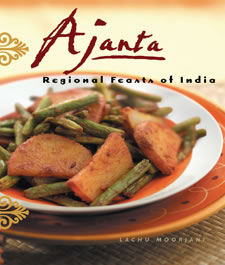Life
Have You Tried This?

No More Saibhaji
 As a child, Lachu Moorjani, who owns the Ajanta Restaurant in Berkeley, Calif., led a one-person revolt against the sameness of food. Growing up in Bikaner, Rajasthan, he was subjected to Saibhaji, that staple dish of Sindhi households, every single day. Saibhaji, which is a stew of spinach, daal and several vegetables, is almost as ubiquitous as bread and a must on the table. “Amongst all my brothers and sisters, I was the one who used to make noises about how can we eat the same thing every day. Finally my mom gave in to that and started cooking other vegetables too.” As a child, Lachu Moorjani, who owns the Ajanta Restaurant in Berkeley, Calif., led a one-person revolt against the sameness of food. Growing up in Bikaner, Rajasthan, he was subjected to Saibhaji, that staple dish of Sindhi households, every single day. Saibhaji, which is a stew of spinach, daal and several vegetables, is almost as ubiquitous as bread and a must on the table. “Amongst all my brothers and sisters, I was the one who used to make noises about how can we eat the same thing every day. Finally my mom gave in to that and started cooking other vegetables too.”
A passionate foodie, he was just as deflated when he first immigrated to California and stayed at a residency hotel that He started seriously cooking for himself and trying to recreate the meals he had eaten in India. This led to the opening of a small restaurant New Delhi Junction, where he
introduced the novel concept of a daily changing menu of regional dishes. Now he owns the 64-seat restaurant Ajanta where his specialty is dishes from all parts of India. He says, “I have a roster of 250 dishes in my database that are used in the menu, so I say that people could come to my restaurant 2-3 times a month for two years without repeating a dish!” Moorjani recently authored Ajanta: Regional Feasts of India (Gibbs Smith) which offers feasts from 12 different regions including Kashmir, Rajasthan and Goa, right from appetizer to dessert, with a detailed shopping list. The menus offer intriguing vegetarian dishes like Goanese Green Pulav, Tandoori Portabella Mushrooms and Rangarang Vegetables, as well as non-vegetarian dishes like Machi Malai Masala and Chicken Pistachio Korma. Moorjani also gives tips on the correct way to brown spices and meat and slice onions. And yes, there’s a whole chapter on how to pair wines with desi food. Although he has chefs doing the daily cooking in the restaurant, the genesis is always in his home kitchen and so the food is very akin to home cooking, with very little oil and fresh ingredients. For him, it’s a labor of love: “I still keep trying new dishes on every visit to India and make my notes, do the research, try them out at home and then feature them in the restaurant.” At home who does the cooking? He laughs, “My wife.” So there’s no advantage in being married to a chef? He says, “She asks me to do it, but I’m too tired!” One thing, however, is certain — Moorjani does not eat Saibhaji every night! |
|||||

 provided all the meals. He recalls, “It was always meat loaf and roast beef and I hated that.” He tried going out to eat at the few Indian restaurants and that was not pleasant either: “In the 70’s most would cook a big batch of curries and freeze them so everything tasted the same, whether it was chicken or lamb or vegetables. They would add a few cosmetic changes and dish it out.”
provided all the meals. He recalls, “It was always meat loaf and roast beef and I hated that.” He tried going out to eat at the few Indian restaurants and that was not pleasant either: “In the 70’s most would cook a big batch of curries and freeze them so everything tasted the same, whether it was chicken or lamb or vegetables. They would add a few cosmetic changes and dish it out.” 
You must be logged in to post a comment Login